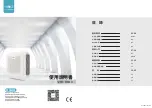
– 67 –
FILE NO. SVM-03008
Table 10-8-1
(3) Check procedures
No.
Procedure
Check points (Symptom)
Causes
1
Turn off the power supply and
remove the P.C. board assembly
from electronic parts base. Remove
the connecting cables from the
terminal block.
2
Remove the connector of the motor
and turn on the power supply. If
OPERATION lamp flashes (once
per second), it is not necessary to
check steps (1 to 3) in the right
next column.
3
Push [START/STOP] button once to
start the unit. (Do not set the mode
to Fan Only or On-Timer operation.)
4
Shorten the line of the restart delay
timer and start unit.
5
Push [START/STOP] button once to
start the unit.
•
Shorten the time of the restart
delay timer.
•
Set the operation mode to COOL.
•
Set the fan speed level to AUTO.
•
Set the preset temperature much
lower than the room temperature.
(The unit (compressor) operates
continuously in the above
condition.)
6
If the above condition (No. 5) still
continues, start the unit in the
following condition.
•
Set the operation mode to HEAT.
•
Set the preset temperature much
higher than room temperature.
7
Connect the motor connector to the
motor and turn on the power supply.
Start the unit the following condition
•
Set the operation mode to FAN.
•
Set the fan speed level to HIGH.
(The unit (compressor) operates
continuously in the above
condition.)
Check whether or not the fuse (F01)
is blown.
Check power supply voltage :
1. Between TP2 and TP3
(AC 220-240 V)
2. Between
e
and
d
(DC 310-340 V)
3. Between
d
of C10 and output side
of IC08 (DC 15 V)
4. Between 12 V and GND
5. Between 5 V and GND
Check power supply voltage :
1. Between CN23 and CN24
(DC 15-60 V)
Check whether or not all lamps
(OPERATION, TIMER, PRE. DEF,
FILTER and Hi POWER) are
indicated for 3 seconds and they
return to normal 3 seconds later.
1. Check whether or not the
compressor operates.
2. Check whether or not the
OPERATION lamp flashes.
1. Check whether or not the
compressor operates.
2. Check whether or not the OPERA-
TION lamp flashes.
1. Check it is impossible to detect the
voltage (DC 15 V) between 3 and 4
of the motor terminals.
2. The motor does not operate. (But it
is possible to receive the signal
from the remote control.)
3. The motor rotates but vibrates
strongly.
Impulse voltage was applied or the
indoor fan motor short-circuited.
1. The terminal block or the cross-
over cable is connected wrongly.
2. The capacitor (C01), line filter
(L01), resistor (R01), or the diode
(DB01) is defective.
3. IC01, IC02 and T01 are defective.
4. IC01, IC02 and T01 are defective.
5. IC01, IC02, IC07 and T01 are
defective.
<Heating and cooling model>
IC03 and IC04 are defective.
The lamps are defective or the
housing assembly (CN13) is
defective.
1. The temperature of the indoor
heat exchanger is extremely low.
2. The connection of the heat
exchanger sensor is loose.
(The connector is disconnected.)
(CN01)
3. The heat exchanger sensor and
the P.C. board are defective.
(Refer to Table 10-4-1.)
4. The main P.C. board is defective.
1. The temperature of the indoor
heat exchanger is extremely high.
2. The connection of the heat
exchanger sensor short-circuited.
(CN01)
3. The heat exchanger sensor and
the P.C. board are defective.
(Refer to Table 10-4-1.)
4. The main P.C. board is defective.
1. The indoor fan motor is defective
(Protected operation of P.C.
board.)
2. The connection or the motor
connector is loose.
3. The P.C. board is defective.
















































